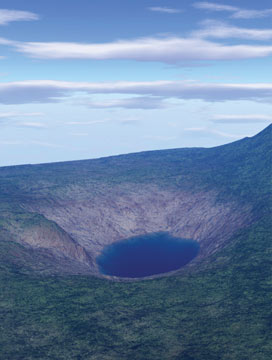|
NEWS NOTES
Long-lost Siberian crater found?
 Courtesy of Luca Gasperini, Bologna University |
| New research suggests Lake Cheko in Siberia may be the long-missing crater from the 1908 impact. |
On June 30, 1908, a ball of fire streaked across the sky in Siberia, then exploded between five and 10 kilometers above Earth. The explosion was so bright that it lit up the night sky across Europe and Central Asia. The resulting shockwaves stripped all of the branches from the trees directly below and flattened trees in a 2,000-square-kilometer area around the epicenter. The explosion, now called the Tunguska Event after the region where it occurred, resulted from the collision of a cosmic object with Earth. When the object exploded, debris should have rained down and an impact crater should have formed. Yet no scientifically reliable evidence of this explosion has been found — until now. A team from Italy has found what they think is a crater formed by a piece of the Tunguska Event. The crater, they say, is now the basin of Lake Cheko, about eight kilometers northwest of ground zero.
Lake Cheko is almost perfectly circular and has a “funnel-like morphology,” with its deepest point quite close to its center, according to Luca Gasperini, a geologist with the Marine Science Institute in Bologna, Italy, who recently studied the lake. These features resemble a typical impact crater, Gasperini says. And the lake’s location is consistent with the estimated trajectory of the object across the sky before it blew up. However, Lake Cheko’s basin is much shallower than impact craters normally are, and an elongated area that stretches toward the northwest mars its almost perfectly circular shape. These irregularities, Gasperini says, are evidence of a “soft crash”: A large piece of the cosmic object survived the blast, but it hit Earth at an oblique angle and a slower speed, thus causing the lake’s slightly irregular shape.
The region is remote and uninhabited, so no one is sure whether Lake Cheko was there before the crash or not. The lake did not appear on regional maps until 1928, but it’s not certain the area had been previously mapped. Gasperini’s team is studying sediment samples taken from the lake’s floor, and they think that sediment only recently started collecting there, indicating that the lake itself is young. Gasperini and his team published their findings in the journal Terra Nova last August.
But the story doesn’t end there, Gasperini says, as more evidence is needed. If a piece of the cosmic object was big enough to survive the blast and create a lake, then other fragments should have survived the blast too, and they would be scattered along the path from the lake to ground zero, says William Hartmann, senior scientist at the Planetary Science Institute in Tucson, Ariz. Previous expeditions to the site of the explosion have not turned up any fragments, but they did not have any reason to focus on the area leading from ground zero to the lake. Should future studies of that path uncover any fragments, it would certainly support the crater hypothesis, Hartmann says. There would probably be other kinds of evidence as well, he says. The rocks around the lake would show signs of trauma. The energy and heat from a cosmic body impact cause “shock-metamorphic” effects, which include rocks that are shattered, melted or deformed in other ways. So far, nobody has looked for this particular kind of evidence, but finding any of these phenomena would be strong support for the idea that an impact created the lake.
An object the size of the Tunguska object will fall to Earth about once a century, Hartmann says. But most of Earth’s surface is covered with water, so these impacts have gone unwitnessed. “[T]he whole history of our planet is punctuated by these events,” he says. But only rarely do we get to see one, he adds.

 Subscribe
Subscribe


